#turkic titles
Explore tagged Tumblr posts
Text


























Aslan / Aslanım Lion / My Lion
A striking name of Turkish origin, Aslan is a boy's name that means “lion.” This powerful title is derived from Old Turkic and was used as an epithet for Turkish emperors in the Middle Ages.
#Muhteşem Yüzyıl#Magnificent Century#mcedit#Muhtesem Yuzyil#kosemedit#weloveperioddrama#perioddramaedit#period drama#historical drama#Hurrem Sultan#Kosem Sultan#Nurbanu Sultan#New Home New Rules#Palace of Tears#The Reign of Sable#Muhteşem Yüzyıl Kösem#magnificent century kosem#Magnificent Century: Kösem#mc: kosem#Muhtesem Yuzyil kosem#Handan Sultan#Mahidevran Sultan#Safiye Sultan#Turhan Sultan#Hafsa Sultan#Awkward-Sultana#historyedit
168 notes
·
View notes
Text
wolfkin npts!



names:
boris, conan, daciana, zev, amarok, amaruq, bardou, conell, arianell, lyall, randelle, reika
meanings + origins at bottom
pronouns:
lup/lups, cani/canis, canid/canidae, howl/howls, moon/moons, claw/claws, snap/snaps, fur/furs, silv/silver, wolf/wolfs, fang/fangs, claw/claws, growl/growls
titles:
___ with a [silver/grey/etc] pelt, the one who howls with a pack, ___ who hunts with a pack, ___ who walks under the shining moon, ___ who dances in the shadows, ___ whose home is the forest

name meanings and origins:
boris ; turkic origin, typically viewed to mean "wolf"
conan ; irish origin, means "little hound" or "little wolf"
daciana ; romanian origin, means "wolf"
zev ; hebrew origin, means "wolf"
amarok ; inuit origin, means "giant wolf"
amaruq ; inuit origin, means "grey wolf"
bardou ; old english origin, means "axe-wolf"
connell ; irish origin, means "strong wolf"
arianell ; welsh origin, means "silver"
lyall ; old norse and scottish origin, means "wolf" or "faithful"
randelle ; english origination means "admirable", while old norse origination means "wolf shield"
reika ; old german origin, means "power of the wolf"

requested by anon!
#id pack#npt#npt list#npt pack#name suggestions#pronoun suggestions#title suggestions#name ideas#wolfkin#anon request
47 notes
·
View notes
Text
Kahn — surname of German origin meaning "small boat"; also the Germanized form of the Jewish surname Cohen < Hebrew kohen, "priest".
Khan — title and surname of Turko-Mongol origin, from Middle Mongol or Old Turkic qaɣan, possibly from Yeniseian.
Don't get them confused.
107 notes
·
View notes
Text
For the Coming of Spring, chapter 2 — 𐰃𐰤𐰋'𐰃𐱃𐰀𐱅𐰃𐰆𐰣 (the invitation) is out!!!!!
Do you guys like the cool Turkic runes I used for the title B)
“The earth is so barren! They say the natives lived there before, but I cannot afford anything more. My father is sick, you see, so I make do with what I can.” The woman sighs, mist drawing in front of her pink lips. “They must have done something. Did you not hear? They are a scary folk. One of them cursed old Natalya Viktorovna into blindness!” “Cursed?” Bilbo echoes, only half-present.
We meet Thorin in this chapter, at long last!
Recommended game to play: spot the other dwarves.
27 notes
·
View notes
Text
My take on the Voynich Manuscript:
It was written by someone who was literate (obviously), artistically skilled, and knowledgeable in a wide range of subjects. Like a proto-Galileo.
It was written partially in abbreviated Latin. Up until very recently, anyone with a Western formal education worth its salt knew Latin.
The author was extremely bright and had a formal Western education at the very least. Likely came from a wealthy family and/or had a rich benefactor. They were important enough that their name and title are possibly still written down somewhere.
It was written partially in Old (High?) German, some 300 years after the language had evolved into Middle High German. Correct me if I'm wrong. That's the equivalent of someone today being fluent in Early Modern (Shakespearen) English. Certainly not impossible, but not something a layman would easily understand.
The author has spent an extensive amount of time studying old texts. Shit that's hard to get your hands on. This person was a scholar that had access to an impressive library.
The Old German/Latin abrv. mishmash is written out phonetically using a version of the old Turkic alphabet. That's kind of vague as hell and covers a huge timespan. Looks like Manichaean script to me, but I'm sure as shit no historical linguist. If anyone knows what it is, that could help us narrow down the timeframe.
The mid-east was bangin around this era. It was THE hot spot for discovery and innovation for pretty much anything.
The author was a polyglot who knew at least two archaic writing systems. They were either well-traveled or had sweet sweet neworking connections to the cool acedemics out east. Specifically: access to their rare books.
The book is coded, presumably to keep the information out of the hands of anyone without the cipher. This makes me think occult, so I'm inclined to believe the alchemist angle. A court alchemist would have access to the crown's deep pockets and private libraries. The coding would conceal any work a benefactor might find scandalous or heretical.
We have a rough timeframe. Finding the author is now a process of eliminating people who wouldn't have access to the knowledge and resources necessary to code the book. So, how many kingdoms in Europe had court alchemists, global connections, and the money to throw around for research? How many of those alchemists studied these subjects?
#mystery files#it might also be worth searching the illustrations for insignias of either the benefactor or occultist group the author belonged to#the voynich manuscript#watcher#watcher entertainment#linguistics#historical linguistics
22 notes
·
View notes
Text
When the PS2 Mod of the 2009 Higurashi Cry Ch. 8 Matsuribayashi pt. 95
I was going to title this as the PS2 Mod Part Final, but I didn’t want to mislead anyone, because there’s still a bit to go.
One of the odd things I noticed while reading the PS2 modded version of the 2009 translation (2010 translation technically, but that’s kind of a whatever) is the tendency for them to switch between using the photographed backgrounds and the newer anime style backgrounds. I wonder if it’s down to budgetary constraints or something else? I wouldn’t claim that the original backgrounds are a higher resolution. Given the positively tiny screen resolution of the 2009 version I don’t think there’s any appreciable difference that you can glean from just a glance. I’m really terrible at discerning resolution just by looking at it, but all I know is that if you play the visual novel as is without making it full screen the window is not a particularly large one. I don’t think it’s a 640x480, but it definitely is sub 720. If File Explorer and MS Paint is to be believed each screenshot is a 642x507 sized picture, so make of that what you will. The 2009 versions are both restricted in the size of visual novel, it wasn’t until the remake and the 07th-Mod that you could adjust the screen resolutions to be bigger than the size of a post it note. Which really makes you think about screen resolutions because this was on a PS2, so you could in theory have played this on a large television. I think I had some point I was trying to make about the backgrounds, instead I got distracted talking about game resolutions.
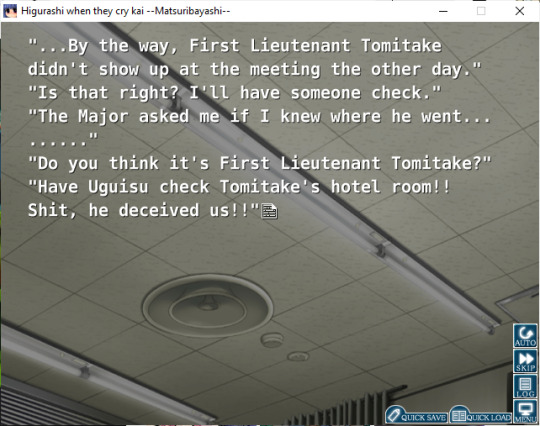
Something I’ve noticed, and you may have as well, is the fact they reuse this ceiling shot a lot for a bunch of rooms. I know it’s generic enough that really who the hell cares, but it just amuses me that this particular background, both in the PS2, and as the basis for the 07th-Mod gets used for multiple hospitals, police stations, and government buildings over the course of the series.

A somewhat peculiar change that only exists in the modded version of Higurashi is the change of Ohtaka’s name to Ootaka. Every other version he appears in; the original translation, the newer one (unmodded), the anime, even going as far back as Tsumihoroboshi and all of those versions there he’s called Ohtaka. It wasn’t a one-time slip either, this was a consistent translation thing in the modded version whenever Ootaka showed up there.

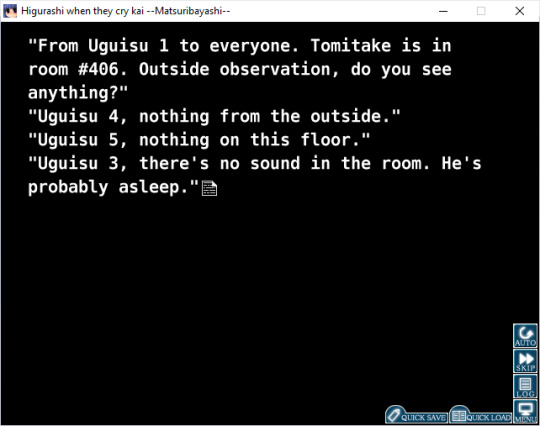

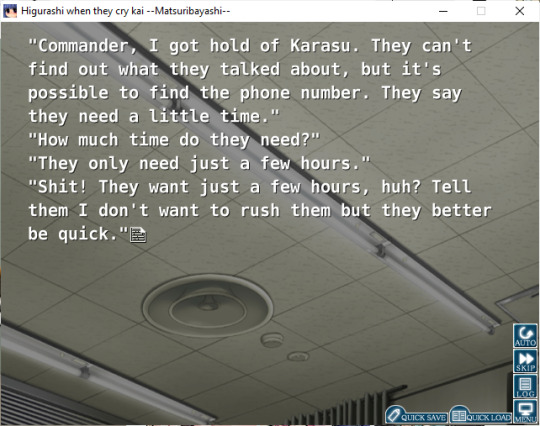

A uguisu is a Japanese bush warbler. The funny thing about the design of this “hotel room” is that this is the screenshot they use in Meakashi for Shion’s apartment. Meanwhile Karasu is apparently a word from the Turkic language that means “black water/river.” The wikipedia page specifically mentions rivers in the Balkans, Asia, a specific river in the Gunma prefecture in Japan, and a few in Turkey. Other references are a Japanese noise musician named Masami Akita (Merzbow), and a fictional prefecture in a game called The Sky Crawlers. I can only assume this is another bird reference, because I doubt Ryukishi07 has a deep undying love of a Turkish volleyball player.

As someone who’s worked retail sometimes the pretty young women with big boobs are the worst people to deal with.

Hibari is the Japanese name for the Eurasian skylark, and Shirasagi is apparently an egret. Isn’t learning fun?

What a peculiar choice of words there. “Final phase symptoms” I can understand why MangaGamer wanted to give the translation a bit of a sprucing up.

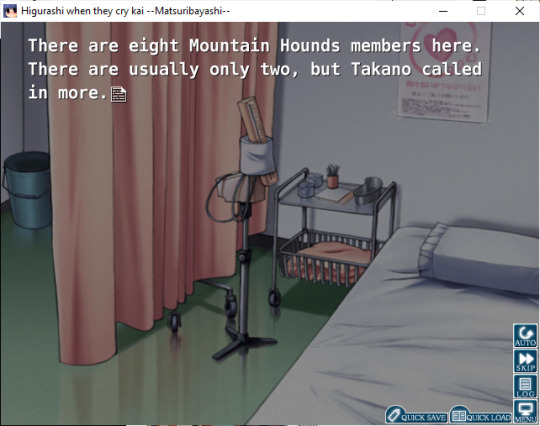

Do not be intimidated by the floating Hanyu. It’s a very definite “we didn’t think we had to finish the sprite” look.
In case you’re wondering the reason there’s the jump from the Ooishi Ohtaka confrontation to the capture of Tomitake to now is because I didn’t screenshot anything worthwhile from those sections. It all played out largely to how it did in the playthrough proper so I didn’t bother capturing the moments again. Which is funny to me because I had to go through those sections twice to capture the floating Hanyu due to accidentally overwriting a screenshot and not being as cautious with my saves as I was during my initial reading of Matsuribayashi. So I definitely could have got more screenshots, but clearly my mind was elsewhere, also don’t be surprised when the screenshots suddenly end seven screens from now.

Bold choice going with this as the background. A quadrisect monitor is when a security monitor is divided into four separate squares, and not when you have four monitors together lined up to make a wall of monitors basically. You can sort of see it in the monitors in the background, the screen divider.


I wonder if anyone at Ryukishi07’s old job ever wondered why he was taking random pictures of the front of the building and the parking lot? Or if they just shook their head at that kooky Ryukishi07 and went about their day?

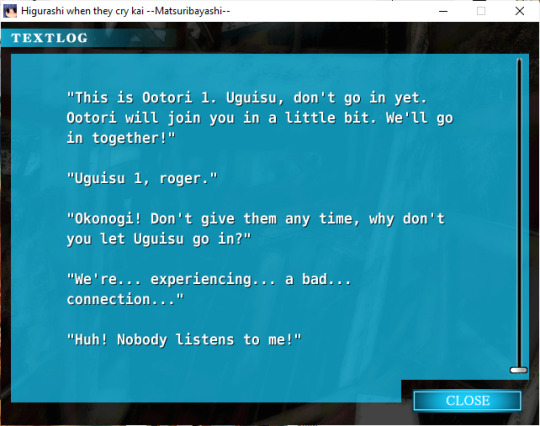
The car chase goes about the same as it did in the modded game. The second screenshot is when the van that shot out Irie’s tires are following our protagonists to the Sonozaki home. Something about this dialogue bugged me, because I was fairly convinced that this was changed in the modded version. To my surprise it wasn’t really, it was all fairly consistent, just the more stilted way of speaking threw me off I suppose.

I do wonder if it’s a common thing in Japan to refer to the era you live in? I’m sure that people in China do refer to the year of the dragon, but I also imagine they put the year onto it. Year of the dragon 2024, you know? Because there’s probably been thousands of years of the dragon at this point. So I’m wondering if the Japanese refer to this being the fifth year of Reiwa (sixth year if you read this after May 2025)?
Rereading this screen I thought of a way you could make Higurashi infinitely worse. Start including eighties slang liberally throughout the dialogue. I’d read it, just to strengthen my ability to handle cringe-worthy dialogue.

Now I know what you’re thinking: 8bit, this is rather an abrupt ending to the sudden inclusion of the 2009 Mangagamer translation of beloved sound novel Higurashi no Naku Koro Ni, alternately known as Higurashi When They Cry, that was modded to include the graphics of the Sony Playstation 2 home video game console. You’re right, it is somewhat abrupt, but I assure you that there really wasn’t anything particularly worth screenshotting from this point forward. The translation plays out the same as it had in the rest of the playthrough. Also during my reading of the PS2 modded version I was also reading the regular unmodified version of the 2009 translation. So I was, admittedly, starting to get somewhat burnt out on it.
The most jarring thing for me when it comes to reading the modded 2009 translation is the lack of some of the CG scenes that were added in the later editions of Higurashi. My theory for this is because of the fact that for several years the Playstation 2 version didn’t have a version of Matsuribayashi, so the mod makers just took sprites from the PS2 versions the other games and inserted them into the mod. Which that must have been annoying to do. Perhaps that’s the reason for the floating Hanyu from earlier on. That must have made the sudden announcement of the DS versions of Higurashi: Kizuna that much more of an irritation. Because suddenly now there is specific sprites for Matsuribayashi, as well as specially made CG scenes.
Which leads us to:
When The DS Higurashi Cry Ch. 8 Matsuribayashi

I apologize in advance for the quality of the pictures, I tried to make them look alright, but there’s only so much taking a picture of a 3DS screen using my phone can do.




I didn’t take pictures of it, but when you boot up the game you need to tap the screen to start it. When you do so it leaves behind a bloody fingerprint oooooohhhhhhh spooooooooky. Oh hell I’ll go back and take a picture of it, and the fragments screen.


See there you go. Instead of the specialized graphics with the thumbnail letting you know which fragment is which it uses this list version. For a brief moment I did consider playing through the DS version as well, but the idea of playing the game entirely looking at it through my phone is a bit of effort I’m just not willing to put in to this. I’m not very interested in what the google translation might say. But circling back, as you can see with the Hanyuu sprites on the DS there are indeed multiple different sprites, perhaps owing to the newer crisper art the DS afforded compared to the PS2 version. Also, it only just now occurred to me that throughout the entire final fight between the gaming club and Takano and the Mountain Hounds Takano wasn’t wearing her military outfit. She was rather conspicuously off-screen during the encounter.

I love the DS and 3DS. It tries so very hard to have one continuous image going across the screens, but the unfortunate reality of the device itself makes that a literal impossibility.
The DS version does include the special scenes of a tormented young Miyoko Tanashi and the final group shot of the gaming club before the credits.


Love giving myself extra work when I decided I didn’t need to include these screens originally. But here they are anyway. Because I love you so much.
Also I had google translate these screenshots, and man that is some gibberish.
In case you're wondering, the red square covering Rena's face is a little panning effect for the picture. There wasn't a way to actually remove it from the picture itself, the face buttons on the DS don't actually do anything during the gameplay itself. The only functional button on the D-pad just takes you back out a menu depending on which screen it's on. It was incredibly lucky for me that the copies I got included these save files from after completing the games. Had they not been there this little digression wouldn't exist, and I think it was kind of interesting. Don't worry, there won't be a sudden inclusion in the other 2009 parts where I suddenly talk about playing the actual PS3 ports of Matsuribayashi. My PS3's disc drive doesn't work, and the discs won't arrive in time anyway.
5 notes
·
View notes
Text

A “şehzade” was the title given to the sons of an Ottoman sovereign. Roughly translates to “prince” in English. It descends from the Persian word shahzad.
“Çelebi” was another significant title, similar to the word “gentleman” in English.
“Pasha” was a title similar to “lord” usually following behind a person’s name as exemplified with “Mehmed Pasha”.
A “bey” was a turkic equivalent to a chieftain and the territory that they ruled was a “beylik”.
Then there’s “ghazi” a word used to describe holy warriors.
#ottoman sultan#ottoman empire#ottoman#turkic#middle eastern history#early modern period#early modern history#medieval#medieval history#culture#history#royalty
11 notes
·
View notes
Text
While everyone is focusing on natlan and the racism it shows, for very rightful reasons at that, let's also address the recent story continuance in honkai star rail.
This update brought forth new characters, hoolay and the borisins. Borisins and hoolay are racist towards turkics, because of the fact that they are ALL villains and carry Turkish/turkic names and titles.
Grey wolves are associated with Turkic countries, along with the color turquoise. Grey wolves are a symbol of freedom and battle in Turkic mythology, and in the mythology of creation in Turkic countries, a female wolf named Asena gave birth to Turks. To make characters based off of an already discriminated against group of countries be SLAVE OWNERS is down right deplorable.
Sure, there is a history of slavery within the history of Turks, but when you have characters based off of Japanese people, who have done WAY WORSE things to Chinese people, read into unit 731 with your own discretion because the shit is down right disgusting, you cannot hide behind that. This is a move mare against us, Turkic people, to discriminate against us.
And this isn't even to mention penacony, which despite being based around times where black people were very prominent in the entertainment industry, from jazz music to references towards Michael Jackson and boothill, who is based off of cowboys that have a very deep history with POC, hoyoverse doesn't give a shit about us.
Boycott these games as much as you can, because this is deplorable behavior.
#hoyoverse racism#genshin impact#honkai star rail#turkiye#racism#hoyoverse#this is mostly a rant tbh#im just very very annoyed#needed to scream into the void.
6 notes
·
View notes
Text

Levedi, the first Voivode of the Hungarians, by Tamás Tulipán 2018
Levedi was the first recorded voivode of the Magyars. According to the Encyclopedia of the History of Ukraine he was also the first recorded voivode in history. I found this interesting given that this term is supposedly of Slavic origin, yet even though the Slavs were known to the Byzantines for centuries it wasn't until a Finno-Ugrian people appeared that it was applied? I searched other sources and came to the same conclusion, which makes me curious. The term was applied to Levedi and to various other Magyar chieftains by Byzantine emperor Constantine VII in his 'De Administrando Imperio' as the Magyars emerged from the Finno-Ugrian and Turkic lands (what is now Russia) and entered Europe proper. The Encyclopedia of the History of Ukraine notes that the term voivode was later used by the Kievan Rus and various other Eastern European peoples afterward.
Constantine VII recorded that the Hungarians lived for three years among the Turkic Khazars. During this time Levedi was summoned by the Khazar chagan, given a Turkic wife, and offered a princely title for his valor: "We have invited you upon this account, in order that, since you are noble and wise and valorous and first among the [Hungarians], we may appoint you prince of your nation, and you may be obedient to our word and our command." (Constantine VII, De Administrando Imperio). Levedi said he could not obey and refused the title of prince but he accepted the woman they offered him, though he had no children by her. Instead the new princely title was given to Arpad or Almos (the info varies depending on the source).
The name Levedi seems to probably be Finno-Ugrian in origin, as a similar name was recorded in a Hungarian charter in the year 1138 CE. One of Prince Taksony's great grandson's in the 11th century was named Levente, which is similar. Though I found an interesting theory in Arnold Toynbee's book Constantine Porphyrogenitus and his World: "Constantine Porphyrogenitus locates the Magyars' habitat in a district, 'close to Khazaria', called Levedhia, before the eviction of the Magyars from there by the Pechenegs. Constantine notes, in the same context, that, in Levedhia, there was a river called Khingilous (alias Khidhmas), and this river is evidently identical with Constantine's River Synghoul and with the river that is now called Cinhul, which joins with the River Tokmak to form the Molochnaya - a river that debouches into the Sea of Azov through a district that is now called 'Lepedika'. The name 'Levedhia' looks as if it were derived from the Greek word livadhia, meaning 'water-meadows'; and this interpretation of the name is confirmed by both Muslim and Western Christian authorities".
#magyar#hungarian#pagan#paganism#europe#history#hungary#european art#finno ugric#medieval history#medieval#literature#etymology
12 notes
·
View notes
Text
Tuva
Name: Aydyn Kuular
Tuva/the territory of what is now Tuva has been ruled by other major empires throughout his lifetime, ever since the Xiongnu era. (209BC - 93AD) After the Xiongnu, it was the Xianbei, the Rouran Khaganate, the Gokturks, the Tang Dynasty, the Uyghur Empire, the Mongol Empire, the Yuan dynasty, the Northern Yuan, the Khogtoid Khanate and Zunghar Khanate, then the Qing. However during the Qing, Tuva was administered by Mongolia.
Some facts
"Dubo" first appears in Chinese records.
Tuvans then were known as "Dubo" (later pronounced as Tuva but also in other forms they were called Toba/Tuba/Tyva/Dyva/Tofalar). They lived in isolated groups in grass tents, ate lily roots, fish, birds, and animals, and wore clothing made of sable and deerskin. Some of the wealthier individuals had horses, but herding was not common. When someone passed away, they would perform a "sky burial" by placing the deceased in trees.
Ruled by Turkic Empires, the Tang, the Uighur Empire, the Mongols
Reappearance of "Tuba" in the Secret History of the Mongols (The Mongols called Tuvans forest people/put them in the forest people category): 13th and 14th centuries
Conquered by the Khotoghoi Kalkha in the 16th and 17th centuries
Passed into the hands of the Zunghars (Mongolic people but not Chinggisid/Khalkha Mongols) in the 1660s (so Mongolia and Tuva would mald about the Zhungars/Oirats together)
Fall of the Zunghars to the Manchu Qing Dynasty in 1755
Tannu Uriyangkhai organised as an aimag (province) in the 18th century under Mongolian rule
Tuva's adoption of Buddhism in the 18th century
Tuva had 5,000 lamas in 30 monasteries and 1,000 shamans in the 1920s
I think that the Tuva we see today was born during the Tang Dynasty era, and the previous personification of "Tuva" or Tuva's ancestor fell during this time. This is because emperor Taizong of Tang sent troops to get rid of the ethnic minorities of Xue Yanto. Now, Xue Yanto used to be an ancient Khaganate in Northeast Asia who used to be the allies of the Gokturks. The Xue Yantuo was a member of the Tile tribe which belonged to the Turks until 583 when it broke into Western and Eastern branches. However they then allied with the Tang against the Eastern Turks. It was vast and it included (what is now) Tuva in it.
The Xue Yantuo and Tang were friendly for a bit, however it changed in 639 with emperor Taizong's actions, and this is when their relationship began to worsen. Ashina Duobi of the Eastern Turkic Khaganate was captured, and Emperor Taizong placed the surrendered Eastern Turks within the borders of the Tang without appointing a new Khan to manage them. However after Ashina's nephew conspired to rebel against the emperor, he then changed his mind and gave the title of Ashina Simo (Eastern Turkic aristoricrat) to the Tang Dynasty, appointing him as the new Eastern Turkic emperor.
Ashina Simo settled in Dinxiang (now Hohhot, Inner Mongolia) in 641. Yinan, who was the Khan of the Xue Yantuo, saw this as an opportunity to launch an attack on the Eastern Turks before the Tang could assist them. Ashina then asked for urgent assistance from the Tang, and they provided. Afterwards, funnily enough, Yinan sent an envoy to tell emperor Taizong that he was willing to live peacefully with the Eastern Turks (lol trying to save face much?). Emperor Taizong sent an envoy back to criticise Yinan but didn't take any further action against the Xue Yantuo.
Sensing that the relationship between Xue Yantuo and the Tang was turning sour, Yinan tried to amend relationships through tribute and intermarriage, however even then there was issues (Emperor Taizong making excuse after excuse to cancel or postpone Yinans marriage to Princess Xinxing, his daughter). Since then, relationship could not be repaired.
After Yinan died, the Xueyantuo descended into chaos. Two of his sons ruled the Xue Yantuo, Bazhuo ruled the West, and Ye Mang, the East. Bazhuo killed Yemang, and ascended fully to the throne, deciding to attack the Tang. He suspected that the Tang border would be unguarded at the Tang were invading Goguryeo, however Emperor Taizong predicted that this would happen. In 646, Emperor Taizong stationed more troops against Bazhuo's attacks. Bazhuo was defeated in the same year.
Bazhuo was a pretty bad leader, and instead of appointing his father's ministers to assist him, he replaced them with his own cronies, causing disarrest among the nobles and eventually causing a rebellion against him. Huihe, he was a vassal of the Xue Yantuo, was a main rebel against Bazhuo.
Seeing all of this chaos take place, emperor Taizong launched an attack on the Xue Yantuo, and the people of the Xue Yantuo panicked, including Bazhuo, who then fled to the Ashide tribe. Huihe, upon hearing this, killed Bazhuo and the remaining royal family members of the Xue Yantuo. After Huihe took most of Xue Yantuo's territory, most of the people of the Xue Yantuo surrendered to the Tang. However some still did try to hold on, and saw Yinan's nephew Tumozhi as the new Khan of the Xueyantuo. However of course, the Tang did not recognise this, and emperor Taizong sent troops to attack the Xue Yantuo, and Tumozhi surrendered. The Xueyantuo then collapsed. Now, the Tuvans paid tribute to the Tang, and they established a monarch-subject relationship. I don't think Tuva was born as soon as the Xueyantuo collapsed but he was young when he experienced the downfall. He's a similar age to Mongolia.
So, that was my long drawn out explanation of when I think the we see now Tuva was "born".
TL;DR, during the Zhenguan period of the Tang Dynasty (Emperor Taizong period) when the Xue Yantuo confederation was destroyed and when the the territory of Tuva/Tuva paid tribute to the Tang, was an approximate date of when Tuva was "born." I think he most likely emerged a century or so before this as of course he wasn't born as soon as the Xue Yantuo collapsed or something, but he was young when he witnessed it's downfall.
Random fact, but in the Tang Dynasty era book "Tongdian", the Tuvans were described as "skiing hunters", and during the Yuan, the Mongols called them the "forest people"/ put them under the "forest people" category.
Tuva, as I have said before, was conquered pretty easily throughout his lifetime. Skipping to the Mongol Empire era, it was conquered by the Mongols in 1207 by Jochi, Chinggis' eldest son. The Mongols then established suzerainty over them. It was ruled by Khalkha Mongols until the 17th century, when they then were ruled over by the Oirats Mongols and were a part of the Dzungarian state. So, for a long time, Tuva was ruled over by Mongols/Mongolic people. For this reason and because of the many cultural similarities between the two, he feels pretty relaxed around Mongolia. Furthermore, during the Qing, although Tuva was a part of China, it was administered by Outer Mongolia. Tuva used to be a part of Mongolia.
In 1911, Mongolia regained its independence back from the Qing. Some regions of Tuva like Tozhu, Salchak, and Khöwsgöl banners wanted to be part of Mongolia, while only the Tannu banner leader appealed to Russia. In 1914, what is now Tuva became part of Russia due to Russian settlers moving in.
However, in 1914, the Russian empire made Tuva its protectorate and allowed Russians to settle there. However even before then, Russians were already settling down in Tuva in the 19the century. In 1860, the Qing signed a treaty with Russia that Russians were allowed to live in Tuva, as long as it was in boats or tents, however by 1881 they were already living in permanent homes. This was the beginning of the Russian colonisation of Tuva, however 1885 was the year of official colonisation of Tuva when the Governor-General of Irkutsk gave permission to a merchant to farm at present-day Turan. From this, more settlements formed. There were around 2000 merchants and colonists by the first 1910's.
This greatly offended the Tuvans and there would be fights between them and the Russians from time to time.
The Qing weren't oblivious to this and were concerned at first, but eventually, internal problems with the Qing meant they didn't have enough time to focus of Russia creeping in on Tuva.
In the 20th century, Tuva was broke asf, their economy was in shambles and there was an increase of poverty in the region, thanks to Russia. The Qing established a rule that Han traders were not to trade in Tuva, and this rule was actually applied, unlike what happened in outer Mongolia. However, Han traders were then allowed into Tuva to compete against the monopoly the Russians had over there, and eventually, like what happened in outer Mongolia, the Chinese dominated commerce there. Many Tuvans found themselves indebted to Han merchants.
I don't think Tuva is some sort of peeping violet, yes, Tuva was ruled by many empires during his life but he is still a proud person who values freedom, and isn't one to completely just bow down. He is moreso someone who just wants to mind his own business, and if (begrudgingly) paying tribute means he'll be left alone for the most part, he'll take it.
Furthermore during the end of the Qing reign of Tuva, when the Wuchang uprising of October 10th 1911 led to a full scale revolution. Mongolia declared its independence from the Qing in early December, and during the second half of December, the Tuvans plundered many Han owned businesses, calling back before to when I mentioned how Tuvans would fight Russians who settled down in Tuva lol. Tuva definitely isn't one to go down without a fight and is quite fierce-willed despite his quiet exterior and history.
In 1921, pro-Soviet Russians took control during the Russian Civil War, and Tuva became a people's republic. By 1926, it had a population of around 58,117 Tuvans and 12,000 Russian settlers. Initially, Mongolian was the official language, and Tuva wanted union with Mongolia, but Mongolia, under pressure, recognised Tuvan independence in 1926.
Explaining Tuvan independence further, jumping back to when I said the Russians declared Tuva as its protectorate in 1914, the new communist Russian government of 1921 declared that this was invalid, so technically, Tuva was an independent state (under very heavy Russian influence/was essentially a puppet state.)
From 1930-31, Tuva underwent changes, including the introduction of a new Latin script for Tuvan. However, attempts at collectivization failed, and pro-Mongolian Tuvan politicians faced execution.
During World War II, Tuvans were conscripted into the Soviet Red Army, and in 1944, the Soviet Union annexed Tuva as an autonomous region within the Russian Soviet Federated Socialist Republic, .allowing Russians to enter Tuva to work in mines and factories. A Cyrillic script for Tuvan was introduced in 1943, and collectivization continued until 1954.
In 1961, Tuva became an Autonomous Soviet Socialist Republic within the RSFSR. The percentage of ethnic Tuvans increased over the years. After the Soviet Union's dissolution, Tuva became a constituent republic of the Russian Federation. In 1989, there were 198,448 ethnic Tuvans, making up 64 percent of the republic's population, and border transit points with Mongolia were opened, though issues like livestock theft and unauthorised pasturing persisted.
Because of Russian colonisation, the identity of the Tuvan people was hurt greatly. Before, they were able to freely live as nomads, hunt, practice shamanism, use their traditional medicines. But after Russian colonisation, forced assimilation, forced settlements, the Tuvan identity was scarred. Despite this, Tuvans resisted full Russification.
Russia kept Tuva closed off from the outside world for nearly 50 years. Even now, Tuva is remote and difficult to access, and is one of Russia's poorest regions. This is why Tuva comes off as closed off/aloof.
Tuva does feel a bit on edge when interacting with other nations who he doesn't feel close to, primarily because of the period of isolation he was put through under the Russians, and he can come off as a bit aloof. He's quite friendly really and he does want to make more friends, he just finds it hard to trust people. For this reason he's lucky he has a cute face to make up for the moody exterior.
He also talks to Yakutia/Sakha about whatever, their conversations are not usually that deep though.
Tuva is trying hard to reclaim his national identity, for example, after the fall of the soviet Union, ethnic Tuvans living in Tuva went up from two-thirds to three-quarters of the population. He's extremely keen on having the lowest amount of contact with Russia possible outside of what's necessary lol.
He probably blasts Huun-Huur Tu and Sainkho Namtchylak.
He and Mongolia, despite their familiarity with one another, do have a bit of a... Rivalry going on about where throat singing originated and who's better haha.
Anyways that's my Tuva. His name is Aydyn Kuular and overall personality wise he is:
Seemingly quiet/aloof
On the inside, quite fierce willed
Very much "I mind my own business, you mind yours."
Is actually quite warm once you get to know him but it's hard for people to get to that point
Avid music lover and is always composing something new!
Tries to reach out to others the best he can
Not a fan of Russia or China
Has his own little projects, doesn't tell a lot of people about them though
#hetalia#Hetalia oc#Historical hetalia#hetalia world stars#hetalia world series#hetalia world twinkle#Hetalia headcanons#Hetalia Asia#Aph Asia#Hws asia#Hws#Aph#Aph tuva#Hws tuva#Hetalia tuva#OC: Tuva#OC: Aydyn Kuular#hws mongolia#aph mongolia#Hetalia Mongolia
30 notes
·
View notes
Text
9/12/24 - Fear & Trembling in Lahore
Applied to renew my passport and noticed that my childhood house was on Ghaznavid Street (named after the 11th century Turkic conqueror).
Finished Moses and Monotheism by Freud as well as a trashy take down of Emperor Ashoka titled Ashoka the (Un)great by Subhodeep Mukhopadyay. The latter of the two was very badly written and the author seemed like a twitter addict who could not help but constantly compare Ashoka to Pakistan and Islamist militants in classic hindu nationalist fashion where even Ashoka's welfare endeavours were criticised simply because he was a buddhist.
Gf read Fear and Trembling to me while I made notes of 3 Behavioral Sciences sections. We then made a gender swapped bumble account for me and I managed to amass 100+ likes and 2 compliments between 4 and 5 AM.
#sigmund freud#lahore#pakistan#diary#studyblr#med studyblr#med student#mbbs#study blog#ashoka#buddhist#buddha#soren kierkegaard
5 notes
·
View notes
Note
Hiiiii I read that excerpt you posted a bit ago and put a little bit of thoughts in the tags but I'm super curious about it actually
I'm curious about the ranks you used, they're used in the Arab military (at least according to a google search) and I'm wondering what inspired you to use them? Are there other inspirations from Arabic stuff in that, or inspo from other places?
Anyway yeah I liked that excerpt a lot and I'm excited to see more stuff from that story in the future :3
Haha!
... yeah
To cut a long explanation short, the societies and cultures of the 12 Worlds are the descendants of transplanted 'Earth' populations carried over into the Worlds through [undisclosed magic means I try not to think too much about]. The Fuhrati Empire, which that excerpt depicts, is one such group, descended from middle eastern societies and thus carrying down a form of the Arabic language and such traditions.
While I was actually hoping to try and get some 'authentically' pre-modern age Arabic / Islamic ranks and titles, I eventually realised that the invention of formal rank structures in organised militaries as I'd recognise them postdates the fall of most of such 'arab' empires to the Ottomans, which meant that the only rank and unit terms I could find were Ottoman / Turkic descended, not 'Arab'. So, after at least an hour of wasted research, I found an Alternate History forum discussion on early Arab ranks, saw that they'd given up on actually finding any, and used a list of modern Moroccan (?) ranks instead since I don't think I'm cut out for coming up with Arabic words just yet
For a documentation of this odyssey, see this thread;
#it was... a struggle#worldbuilding#writeblr#writing#my wips#my writing#writeblr stuff#my worldbuilding#also; for future reference the Fuhratis aren't the only arab-descendant society here#and over the centuries they've probably localised to incorporate the culture of their neighbours on the continent
2 notes
·
View notes
Text
Kök Tengri - Mythology and information
In Old Turkic, Tengri signifies God or Sky. Tengri, also known as Gök God or Kök Tengri, is the ultimate spirit of the sky, according to Tengricism. The Orkhon Inscriptions, where Tengri is the earliest deciphered term, give early proof of the significance of this notion.
Tengri, the great sky god, is the most revered Turkish divinity. While the majority of Turkish history has been polytheistic, Tengriism has existed as a monotheistic religion for millennia. Tengri, also known as Kök Tengri or Gok Tengri, is the first primordial deity and creator god. We don't know what he looks like, but he's all-powerful and fair. Later beliefs of the deity, no likely inspired by more contemporary philosophies, saw him as the force of good in opposition to Erlik's evil.
History-
Tengri was the Göktürks' national god, also known as the "god of Turks" (Türük Tängrisi). Tengri's mandate established the Göktürk khans' authority. These monarchs were widely considered as Tengri's sons, representing him on Earth. Tengrikut, kutluġ, and kutalmysh were titles given to monarchs who were believed to have gained kut, a spiritual energy provided by Tengri.
Prior to foreign intrusions, the Turkic idea of tengri was viewed as the heaven or the will that controlled the heavens, most likely a force. This resulted in the notion of a personal being. Initially, when Turkic people took over other religions, the term tengri became the name of a (personal) deity or "higher being"
Engri was the primary deity worshipped by the ruling elite of Central Asian steppe peoples from the sixth to ninth centuries (Turkic peoples, Mongols, and Hungarians). It lost significance when the Uighuric kagans declared Manichaeism the state religion in the eighth century. The Huns and early Bulgars spread Tengri religion over Eastern Europe.
Engri is thought to be the supreme god who created everything. In addition to the heavenly deity, they had smaller divinities (Alps) who served Tengri's objectives. Gök Tanrı was the father of the sun (Koyash) and moon (Ay Tanrı), also known as Umay, Erlik, and occasionally Ülgen.
Mythology-
Tengri was the most important deity in the Turkic pantheon, in charge of the celestial realm. Tengri is said to be related to the Indo-European sky deity *Dyeus, and the organisation of the reconstructed Proto-Indo-European religion is closer to that of the early Turks than to the religion of any Near Eastern or Mediterranean nation. In Christian Turkish, Tengri refers to Jesus' father, who is known as "Tengri Oghli" (Son of God) and "Mshikha Tengri" (Messiah God). Tengri is likened to both Allah and Khuda. Apart from foreign religious influences, as far as is known today, the original Turkish understanding of Tengri was "heaven" or a spirit governing in heaven. This spirit was most likely conceived as a power, similar to "mana" in contemporary ethnology.
The most important current evidence of Tengri worship is contained in the Old Turkic Orkhon inscriptions from the early eighth century. These inscriptions, written in the so-called Orkhon script, provide information about the Turks' legendary beginnings. The inscription dedicated to Kul Tigin includes the following paragraphs (in the translation supplied by the Language Committee of the Ministry of Culture and Information of the Republic of Kazakhstan): "When the blue sky [Tengri] above and the brown earth below were created, between them a human being was created." My forefathers, Bumin Kagan and Istemi Kagan, ruled over humanity. They controlled the people according to Turkish rules, led them, and prevailed" (face 1, line 1); "Tengri causes death. The Old Turkic phrase "Öd Teŋri yasar kisi oγlu qop ölgeli törürmis" (face 2, line 9) and "You passed away (lit.: 'went flying') until Tengri gives you life again" (face 2, line 14) refer to the creation of humans with the intention of death. The ancient Turkic people believed that Khagans ruled by Tengri's will, as stated in the Orkhon inscriptions: "I, Tengri-like and Tengri-born Turk Bilge Kaghan, succeeded to the throne at this time" (Old Turkic: Teŋiriteg Teŋiride bolmuš Türük Bilge Qaγan bü ödüke olurtum).
Tengri, according to one Turkic story, is a clean, white goose who always hovers over an unending stretch of water, representing time. Ak Ana ("White Mother") screams out to him "Create" beneath the ocean. To alleviate his loneliness, Tengri produces Er Kishi, who is not as pure or white as Tengri, and together they build the universe. Er Kishi transforms into a demonic figure who attempts to deceive and entice others into its darkness. Tengri adopts the name Tengri Ülgen and withdraws into Heaven, where he attempts to guide humans through sacred animals he sends among them. The Ak Tengris inhabit the fifth level of Heaven. Shaman priests who want to achieve Tengri Ülgen never get beyond this stage, where they communicate their aspirations to the divine guides. Returns to Earth or to the human level occur on a goose-shaped vehicle.
What he's associated with/his symbols-
the sun, the moon, the top of yurts, the wolf, and the deer. The wolf and the deer are the common ancestors of most of the populations that participate in the Tengri religion.
6 notes
·
View notes
Note
Ship meme: SELF INDULGENT BUT SHHH
Hades/Kanon? 🥺
*puts my cool glasses on* :3 I see you Hades/Kanon (or a ship name I made for them, HaKan, fun fact, Hakan is Turkish name meaning Emperor/Supreme Ruler which comes from Khagan, a title of imperial rank in Turkic languages, so seeing Hades being well, a ruler of the Underworld and we know Kanon's ambitious was hehehe) Squick / Just nope / A trainwreck you can’t look away from / Mehh but they are bloody everywhere / Not interested but no negative feelings / I need to see how I could make it work / BroTP / Cute / I love them / They rented a room in my mind and are here to stay
A greek g-d is needed to handle to tame Kanon, no one else can handle Kanon. Hades is happy to provide that discipline through his kindness. Kanon's nature is to challenge almost everything in a way Hades finds it interesting and has an interest on the new golden Gemini, powerful and dangerous, seeing him as a potential opponent/rival. But down the line, they realised that deep down they got a cue tsundere side they both tease...dangerously about it. It was almost a game...until feelings got involved, Hades was the first who fell in love with Kanon in a slow burn fashion whilst Kanon was in denial "why do i have soft spot for the Underworld ruler...I wonder why?" I love the goth/unhinged pairing due to the aesthetic and how Hades is like "cool" to Kanon's antics, he looks unbothered by it but sometimes secretly he is just amused how Kanon can go. Also I still have that conspiracy theory if Kanon was a specter and wins the holy war for Hades, that Hades would give something to rule to make his consort happy-ish or less desperate for power. And Kanon is attracted to Hades' powerful personality that he can kneel to him more easier compared to Pose and Athena heheh
3 notes
·
View notes
Text
Whose history?
But what are the facts? Who has the greater claim to Anna, Yaroslav the Wise and Volodymyr the Great — Ukraine or Russia? And can Ukrainians and Russians really be considered to be the same people? The short answer is — no.
At its height in the mid 11th century, Kyivan Rus was the largest state in Europe and, because of its control of key trade routes, one of the richest. According to the Russian Primary Chronicle, the state was founded in 882, when Prince Oleg, the brother-in-law of Rurik, founder of the Rus royal dynasty, conquered Kyiv, made it his capital, and proclaimed it the “mother city of the Rus.”
Kyiv was at that time inhabited by Slavs who paid tribute to the Khazars, a confederation of mainly Turkic tribes who dominated the steppe land in what is now eastern Ukraine, eastern and southern Russia, the Caucuses, and parts of Central Asia as far as the Aral Sea in the east.
Under Oleg, the various Rus states united into a single political unit stretching from the Baltic Sea, Lake Ladoga and Lake Onega in the north, to the tip of Crimea (though not the whole of the peninsula) in the south. What is now southern and eastern Ukraine, though partly settled by Slavs, was mostly not part of Kyivan Rus, but was under the shifting and changing control of various tribes and invaders from the east.
After the reign of Yaroslav the Wise, from 1054, Kyiv Rus underwent gradual disintegration due to feuding between the rulers of its various constituent principalities over the succession to the title of Grand Prince of Kyiv.
Kyivan Rus was finally doomed by the invasion of the Mongols from the east in 1237–1240. The state broke apart into separate Rus principalities that paid tribute to the invaders for centuries to come.
Successor states
After a long period of domination by the Mongols and their Turkic successors the Golden Horde, control of the area that had been Kyivan Rus was by the beginning of the 16th century split between two large states. The Grand Duchy of Lithuania controlled most of what is now Ukraine and Belarus (apart from southeastern Ukraine and Crimea, which was under the Crimean Khanate), while the Grand Duchy of Muscovy occupied what is now the northeastern part of modern European Russia.
However, the grand dukes of Muscovy laid claim to all of the lands of the former Kyivan Rus, seeing themselves as direct successors to that ancient state. Under the successor state to Muscovy — the Tsardom of Russia — the area under Moscow’s control grew immensely, stretching through Siberia to the Far East. However, it still did not directly control most of the land that would one day be today’s Ukraine, or the “mother city of Russia” — Kyiv. That was still under Polish-Lithuanian control.
An uprising against Polish control in the east of Ukraine under Ukrainian Hetman Bogdan Khmelnytsky in the mid 17th century led the lands east of the Dnipro River and the city of Kyiv to become autonomous under the Cossack Zaporizhian Sich, at the price of Khmelnytsky’s oath of allegiance to the Russian Tsar. The south of Ukraine, from its modern western to eastern borders, remained under the control of the Ottoman Empire. After the Polish-Lithuanian Commonwealth lost a war against the Tsardom of Russia in 1667, the rest of eastern Ukraine, including Kyiv, was ceded to Russia by Poland.
After the Russian Empire was proclaimed in 1721 under Peter the Great, Moscow continued to expand its control westward and southward, defeating the Polish-Lithuanian Commonwealth, and by the end of the 19th century gaining control over most of what is now modern-day Ukraine. Following a brief struggle for independence when the Russian Empire ended in 1917, Ukraine (apart from its far western regions) was effectively absorbed by Russia in 1922 under the Soviet Union, as the Ukrainian Soviet Socialist Republic.
Modern Ukraine assumed its present shape after the Soviet annexation of western Ukraine in 1939 and the granting of Crimea to Ukraine in 1954 by Soviet leader Nikita Khrushchev. These were the borders assumed by Ukraine when it gained independence following the collapse of the Soviet Union in 1991.
Who were the Rus?
It is clear that the Russian state that emerged from the ashes of the Soviet Union, the Russian Federation, is a direct political successor of the Grand Duchy of Muscovy. But due to the destruction and fragmentation of Kyiv Rus by the Mongol invasion, modern Russia cannot be said to be the direct successor of Kyivan Rus, and its claims to be the direct inheritor of Kyivan Rus lands and history are spurious.
However, the same could be said for the modern Ukrainian state, which presently covers an area that has been occupied by numerous, tribes, peoples, nations, states and empires over the millennia, of whom the Kyivan Rus were by no means the first.
There is another twist to the tale: Oleg, the founder of Kyivan Rus, was the son of Rurik, who is generally thought to have been a Varangian — what we nowadays call a Viking.
The Rus, from which the countries Belarus and Russia derive their names, appear to have been a Scandinavian people who adopted Slavic culture and language after taking political control of the area. While this is disputed by Russian scholars, a similar case can be seen in western Europe, where Vikings settled in northern France and adopted French language and culture while lording it over the locals; they were the Normans, or Norsemen — Vikings. One of their leaders, William the Conqueror, invaded England in 1066 to bring a French-speaking nobility to power there.
So Putin’s propaganda narrative obscures the complex and uncertain history of the region, which intertwines Slavic, Scandinavian, Khazar, Turkic, and Mongol ruling families, states and empires, as well as shifting Ottoman, Lithuanian, Polish, Swedish and Russian imperial influences on the lands that centuries before were home to Yaroslav the Wise and his daughter Anna.
Putin’s claim that they or Volodymyr the Great are intrinsically Russian makes no more sense than to claim that the Norman kings of England are intrinsically British — it is a politically expedient claim, not a historically accurate one, of the type frequently used by past kings, emperors and dictators to justify claims to lands that are not their own.
4 notes
·
View notes
Text
Nicknames for borzois
From time immemorial, it has been customary for borzois to give nicknames that carry a certain semantic and emotional load. These traditions continue to this day. True, the “theme” of nicknames has changed significantly over time.
Since past centuries, the speed, vigilance and dexterity of these dogs have traditionally been reflected in the nicknames of borzois: Bystryy(fast), Veter(wind), Veterok(breeze), Vikhr'(whirlwind), Zorkyy(sharp-sighted), Krylat(winged), Lovkiy(dexterous), Polyot(flight), Prytkiy(quick), Bystra(female version of fast), Lyotka(flying), Krylatka(female version of winged), Provorka(agile), Pul'ka(bullet), Rezva(frisky), Shustra(nimble).
The nicknames given by the names of birds echo this theme: Berkut(golden eagle), Krechet(gyrfalcon), Korshun(kite), Sokol(falcon), Oryol(eagle), Strepet(little bustard), Golubka(female pigeon), Ptashka(birdie), Chayka(gull).
One of the indispensable qualities of the old Russian borzois - anger towards the beast - was reflected in the nicknames: Zver'(beast), Zlobach(vicious), Lyutyy(fierce), Svirep(ferocious), Lyutaya(female version of fierce), Tiranka(female tyrant).
A very peculiar approach of ancient hunters to the names of borzois is visible in the use of imperative verbs: Dogonyay(catch up), Doyezzhay(reach),Zamechay(notice), Nakryvay(cover), Porazhay(hit), Primechay(take notice), Raskiday(scatter), Sokrushay(crush), Khvatay(grab). Thus, hope was expressed for the future outstanding qualities of the dog.
Often the nickname was supposed to reflect the prowess and courage of the dog, which, of course, does not give the beast a descent during the persecution: Karay(punish), Katay(ride), Obizhay(offend), Nalyot(raid), Pobedim(win), Udaloy(daring), Shvyrok(throw), Nalyotka(female version of raid), Otvaga(courage), Raskida(female version of scatter), Slava(glory), Udalaya(female version of daring).
Oriental nicknames have always been quite popular with Russian borzois: Abrek(is a North Caucasian term used for a lone North Caucasian warrior living a partisan lifestyle outside power and law and fighting for a just cause), Agakhan(is a title held by the Imām of the Nizari Ismāʿīli Shias), Alan(In honor of a nomadic tribe in Asia), Anchar(antiaris), Bulat( 1)male name of Persian origin, which was borrowed by the Turkic peoples. The etymological meaning of the name is "steel". From the Turks, the name Bulat came to Rus', where it was used before the spread of Christianity. 2) is a type of steel alloy known in Russia from medieval times), Kuchum(was the last Khan of Siberia who ruled from 1563 to 1598), Lezgin(In honor of the Dagestan people, one of the indigenous people of the Caucasus), Nayan(was a prince of the Borjigin royal family of the Mongol Empire), Sultan, Turkmen(are a Turkic ethnic group native to Central Asia), Shaitan, Gulji(Presumably a goat), Fatma(Arabian woman name).This partly indirectly confirms the hypothesis of the eastern route of penetration of sighthounds into Russia. Well, after quite a lot of oriental sighthounds were brought in the 19th century, as already noted, the number of such nicknames naturally increased.
Many nicknames displayed character traits, one might say, desirable for a borzoi: Azarnoy(venturous), Nakhal(smart aleck), Razboy(robbery), Retivyy(mettled), Smelyy(brave), Buyana(brawl), Zadira(bully), Nagla(Insolent), Plutovka(cheat), Shel'ma(rogue), Shalun'ya(naughty). And this approach is understandable and traditional.
However, among modern nicknames, characteristics that are not very desirable for a greyhound began to appear more and more often: Dikar'(savage), Dobryak(kindley), Dikarka( female version of savage), Laska(caress), Nedotroga(touchy), Tikhonya(cuiet).Of course, the owners have always cherished and protected their dogs.
And an indicator of this attitude are the nicknames that emphasize the value of the dog: Bestsen(priceless), Dorogoy(dear), Podar(gift), Lyubim(loved), Serdechnyy (hearty), Yakhont(one of the obsolete names for the red and blue jewelry minerals corundum), Almazka(diamond), Biryuza(turquoise), Brasletka(bracelet), Nagrada(award), Serebryanka(silver), Yashma(jasper).
The spectacular appearance of sighthounds, especially Russian borzois with their luxurious coat, impresses even the inexperienced. And it is not for nothing that a fairly large number of nicknames, both in the past and now, emphasize this beauty. Here are just a few of them: Krasavchik(handsome), Ladnyy(fine), Prigozhay(comely), Blyostka(Glitter), Divnaya(marvelous), Igrushka(toy), Krasa(beauty), Krasotka(beauty).
In our times, nicknames taken from the names of plants of our homeland have become widespread among borzois: Bagul'nik(Labrador tea), Klyon(Maple), Kovyl'(feather grass), Lyutik(buttercup), Shalfey(sage), Beryozka(Birch), Yolka(Christmas tree), Kalina(guelder rose), Medunitsa(lungwort), Melissa(lemon balm).
As well as lakes, rivers and other geographical names of Russia: Baikal, Valdai, Don, Sayan, Angara, Volga, Katun.
Borzois, like some other domestic breeds of hunting dogs, often have nicknames that reflect natural phenomena: Grom(thunder), Iney(hoarfrost), Rassvet(dawn), Tuman(fog), Volna(wave), Groza(thunderstorm), Dymka(mist), Metel'(blizzard), Purga(snowstorm).
It can be seen under the impression that the Russian nobility was engaged in hunting with borzois in past centuries, a lot is now found among borzois and "titled persons": Barin, Knyaz', Sudar', Tsarevich, Tsar, Boyarynya, Grafinya(Countess), Knyazhna, Printsessa(Princess).
Borzois are considered an ancient Russian breed, the personification of old times. And, probably, the appearance of nicknames that came from legends, fairy tales and from the names of historical figures is connected with this: Berendey, Yermak, Kudiyar, Leshiy, Orlov, Sadko, Bylina, Skazka, Snegurochka.
1 note
·
View note